There are illustrated instructions for English Paper Piecing in The Patchwork of the Crosses (POTC).
EPP is the slowest and most difficult method in the book, but it is included because it is the method that Lucy Boston used to make all of her quilts, as described in The Patchworks of Lucy Boston by Diana Boston.
The more you know about EPP and Inklingo, the easier it is to choose the method that is best for you.
Like Fern, we can be inspired to use the designs in the fabric the way Lucy Boston did, but sew them more easily and faster than was possible in her day.

INKLINGO AND ENGLISH PAPER PIECING
In Wednesday Tute 15, we showed you how you can print the Inklingo layouts without seam allowances on a variety of template materials to make your own perfect templates.
In Wednesday Tute 16, we showed you how you can print the Inklingo layouts with seam allowances on fabric to use the fabric more efficiently and to make the shapes faster and easier to cut.
HOW TO ENGLISH PAPER PIECE – PART 3
This time we summarize the different ways to baste the fabric to the paper templates.
Basting is a time-consuming step, so I prefer to just print all of the shapes on fabric with Inklingo and skip basting entirely. With Inklingo, I can go straight to the fun part.
However, if you prefer to baste and whip-stitch, basting is part of the preparation.
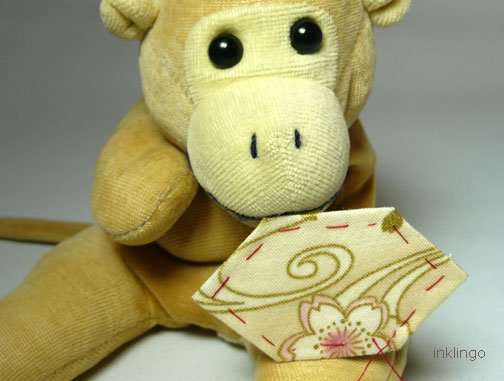
Basting through the paper:
- traditional, relaxing and portable
- ideal for light-weight templates like freezer paper
- use up any old thread
- leave the knot accessible because it is necessary to remove the thread to remove the paper
- papers can be reused, but are more likely to be damaged during removal
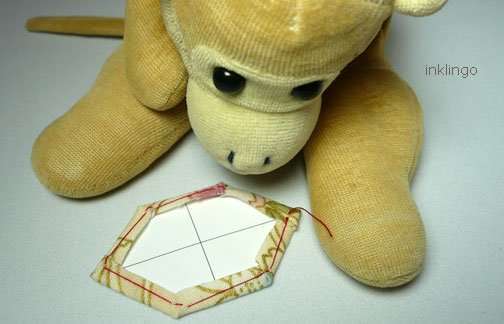
Basting at the corners only:
- traditional, relaxing and portable
- requires stiffer templates, which are difficult to fold
(Templates are folded at Y-seams for traditional whip-stitching with right sides together, as described in a future tute.) - use up any old thread
- doesn’t secure the edges well on large shapes
- easy to remove the papers and reuse
- basting stitches can be left in forever to hold the seam allowances in position
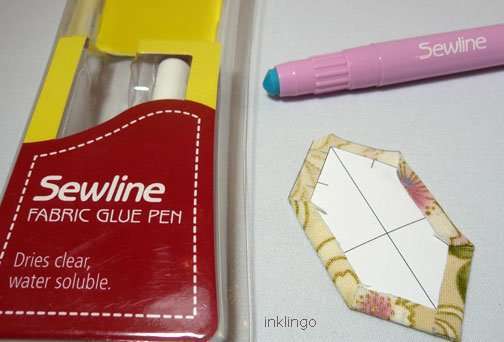
Glue Stick along the edges:
- not traditional, so not appealing to those who prefer sewing with a needle & thread
- may be too messy to be portable
- a rotating mat is an advantage to speed it up
- works with any template material
- papers can be re-used if you don’t use too much glue
.
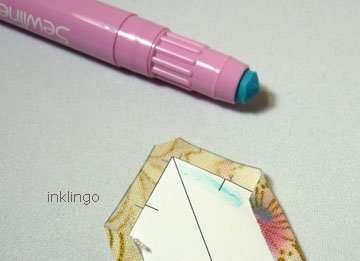
TIPS - If glue spreads to the edges, the needle and thread will drag through glue, so take your time to do it right the first time!
- It is necessary to peel up the seam allowances to remove the templates. If you use too much glue, the seam allowances are ruffled and fray and may not lie flat.
- It is easy to use too much glue, so practice using as little as possible.
- Keep the glue pen sealed so it doesn’t dry out.
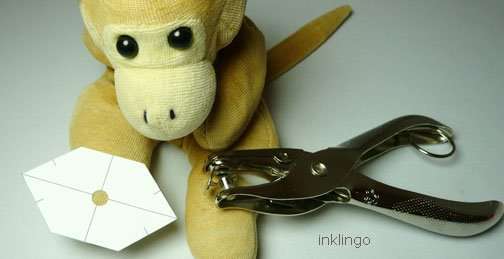
In every case, it is necessary to remove the templates when all sides of each shape are sewn.
TIP This time-consuming extra step can be a little easier if you punch a hole in the papers before basting, so you can use a toothpick or orange stick to lift the template.
Inklingo quilters like Fern prefer to sew POTC with a running stitch by hand (video).
As Fern says, Inklingo has transformed my stitching life! It really is so much easier and faster than EPP. And without open seams, the piecing looks so much better too. I am having such a lot of fun and making remarkably rapid progress with Inklingo POTC that I am now relooking at all sorts of patterns for Inklingo possibilities!
You can see more of Fern’s fabulous POTC blocks on the blog too.
In the next few Wednesday Tutes, we’ll look at more reasons to use Inklingo when you EPP because Inklingo has advantages for quilters who enjoy whip-stitching and paper templates too.
- No-waste, faster Fussy Cutting
- Design Ideas like 300 Pieced Hexagons
- Sewing instructions and worksheets in the Inklingo Design Books
- English Paper Piecing Rescue
MORE WEDNESDAY TUTES
You can catch up on our other Wednesday Tutes now too:
- EIGHT Wednesday Tutes for Pieced Hexagons
- FIVE Wednesday Tutes for Double Wedding Ring
- ONE Wednesday Tute for Kaleidoscope Stars
- TWO Wednesday Tutes for English Paper Piecing
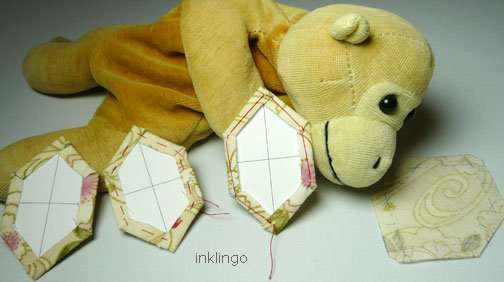
TO BASTE OR NOT TO BASTE?
THAT IS THE QUESTION
With Inklingo and English Paper Piecing, you can make wonderful designs with hexagons, diamonds, triangles, shapes with curves (Clamshell, Apple Core, Dresden Plate), and many others. (Inklingo Index of Shapes)
There is inspiration in the Smart Shopper’s Idea Book (free download).
Have you like the Inklingo FB page yet? If you haven’t, please do. Thank you!

The simple, fragile beauty of the anemones in our garden remind us to count our blessings, not just on 9/11, but every day.
ARE YOU SUBSCRIBED?
I hope you will subscribe to the blog (top of right side-bar), so you don’t miss more about English Paper Piecing in our next Wednesday Tutes!
Thanks for visiting. See you again soon!
Linda & Monkey
New to Inklingo? Order and download free shapes and start sewing in the next few minutes. Quick Start (Always FREE.) There are triangles, diamonds, and squares in the free collection—great for dozens of different blocks.
$10 Coupon! 7 Year Anniversary Special on the handbook


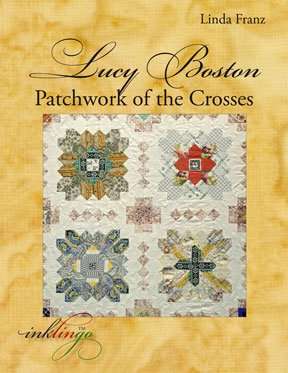
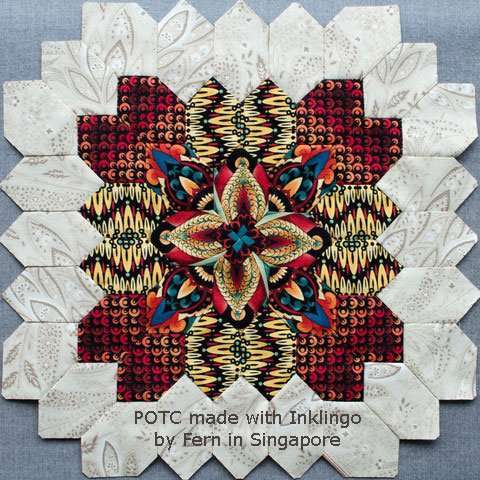
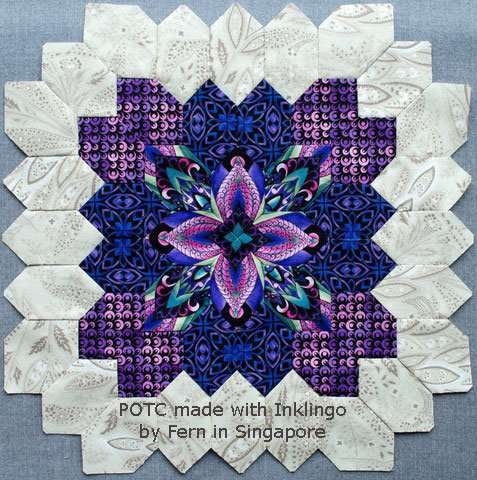


Linda and Monkey,
Thank-you for the picture of the anemones at the end of this Wednesday’s tute. They always remind me of Granny. Please could you remind me where the G.F.G.E.P.P.U.F.O. is, because I’m sure it’s in one of the boxes I moved into the quilting room when Doug moved to University? Those Grandmothers’ Flower Garden hexagons may be able to be rescued by Inklingo!
Sandra
Stunning blocks and thanks for the advice about basting.
What are the actual pieces called?
Not hexis obviously but my brains on melt down and I cant think of the name of that particular template lol duhhhh Help!!
: ) Lyn
Thank you gain for the wonderful tutorial. Fern’s blocks are beautiful. I look forward to more of your tutorials. AND Fern’s next quilt 🙂
Linda and Monkey, Thank you so much for featuring my blocks. More than a decade ago I attempted the beautiful Lucy Boston POTC quilt using EPP and abandoned it after about 7 blocks. I started from scratch this year with Inklingo, have completed all my 56 blocks and connectors and am beginning to assemble to entire quilt. Inklingo makes sewing so accurate, easy and fun. And with a little experimentation, works fabulously for fussy cutting too. Thank you – Inklingo has been transformative and I am plotting my next Inklingo quilt. The hard part is that there are so many to choose from! fern